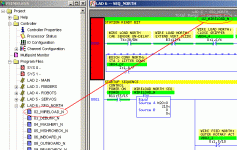Maintenance Man
Member
Hi to all,
I have been using Allen Bradley RsLogix 500 software for over 12 years in which, when I change or write programs, I kind of hack at them to get my results. I would like to come up with a way that is quicker. I am trying subroutines which make programs more clearly to me in organization and more easy to fallow. I am just looking for a better way to program ladder logix. Am I on the right path or is there a better way to program more clearly? Thank you all for your help.
I have been using Allen Bradley RsLogix 500 software for over 12 years in which, when I change or write programs, I kind of hack at them to get my results. I would like to come up with a way that is quicker. I am trying subroutines which make programs more clearly to me in organization and more easy to fallow. I am just looking for a better way to program ladder logix. Am I on the right path or is there a better way to program more clearly? Thank you all for your help.



